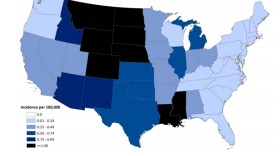Researchers with the National Center for Atmospheric Research and the Centers for Disease Control and Prevention found that increased West Nile outbreaks correlated strongly with above-average temperatures in the preceding year.
They also found wet weather influenced outbreaks – although the actual impact varied by region. In much of the West, wetter-than-average winters correlated with above average outbreaks. Researchers found a different picture in the eastern U.S., where West Nile outbreaks correlated with fall and spring seasons that were drier than average.
That may seem counterintuitive; after all, doesn't a wet spring usually mean more mosquitoes in the summer, since they need water sites to reproduce?
Turns out it's not that simple when it comes to West Nile virus.
"There are actually three different mosquito species in the United States that are responsible for transmitting the virus," said the study's lead author Micah Hahn, a scientist with NCAR and CDC.
They're all Culex species mosquitoes, but their preferences are different when it comes to breeding habitats. Those eastern mosquitoes prefer standing areas of dirty, stagnant, nutrient-filled water.
"Think if you left a plant container in your backyard and it rained, filled up with water, and then some algae and things started to grow on top," Hahn said. "That would be a perfect breeding habitat for these mosquitoes."
Colorado mosquitoes, on the other hand, like to breed in bright, sunlit water that's often associated with irrigation ditches.
In addition, heavy rainfall can flush out mosquito eggs from shallow breeding grounds.
"That's what we think could be driving this finding, that when there's lower than normal precipitation, there's a higher risk of West Nile in the east, because those populations don't get washed out by too much rainfall," Hahn said.
For this study, Hahn and fellow authors conducted a detailed statistical analysis of weather data across the contiguous United States from 2004 to 2012. They found that warmer temperatures were strongly correlated with higher rates of West Nile virus – likely because milder weather means higher survival rates for mosquitoes, their eggs and larvae.
Based on the findings, Hahn and her co-authors are working on creating a model that could forecast West Nile risk across the U.S. before the season comes. Because there's currently no vaccine for human cases of West Nile, efforts to control it center on keeping people from being bitten. But health officials often can't recommend efforts like spraying until West Nile-infected mosquitoes are already detected.
"Our thought was that if we can use readily accessible weather data, we might be able to give everybody a heads-up before the season comes, in terms of what their risk was for the coming season," Hahn said.
Having advance warning could help public health agencies and local governments get ahead of West Nile in the spring, before it peaks in summer months. The findings are illustrated in a study appearing in the American Journal of Tropical Medicine and Hygiene.







